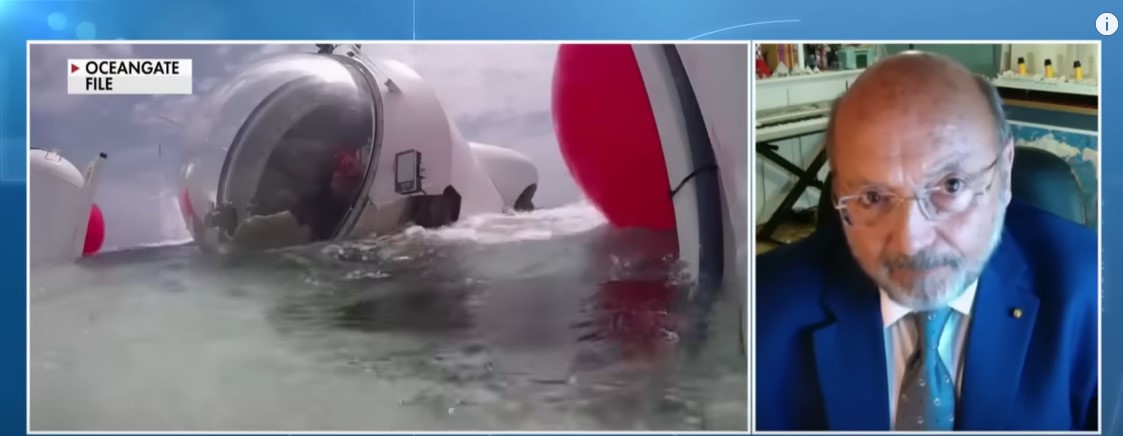On June 18, 2023, the Titan submersible operated by OceanGate Expeditions went missing in the North Atlantic Ocean, about 435 miles south of St. John’s, Newfoundland, according to Canada’s Joint Rescue Coordination Center, spurring a desperate international rescue effort. Rescuers are racing against the clock because the oxygen supply could run out by approximately 6 a.m. Thursday.
In the latest news, the Coast Guard wrote on Twitter that a Canadian P-3 Orion had “detected underwater noises in the search area.” Searchers then moved an underwater robot to that area to search. However, those searches “have yielded negative results but continue.”
The submersible was designed to accommodate five people and was carrying an expedition of tourists to view the wreckage of RMS Titanic.
As of this writing, the five people in the missing Titan submersible are still unaccounted for and are presumed dead according to speculation by experts. The company that sent a tourist submersible to the Titanic wreck has faced safety questions before.
In 2018, David Lochridge, the former director of marine operations for OceanGate, the company that owned the Titan submersible, raised concerns about the safety of its design. When he refused to greenlight manned tests and raised his concerns, the company fired him.
The Washington-based company later sued Lochridge for disclosing confidential information. Lochridge then counter-sued, alleging that OceanGate had fired him for voicing his concerns about the vessel.
After Lochridge’s inspection report, OceanGate called a meeting that included the company’s CEO, human resources director, and engineering director. At the meeting, Lochridge discovered why he had been denied access to the viewport information from the engineering department: The viewport at the forward of the submersible was only built to a certified pressure of 1,300 meters – although OceanGate intended to take passengers down to depths of 4,000 meters, according to the complaint.

The documents say Lochridge learned the viewport manufacturer “would only certify to a depth of 1,300 meters due to the experimental design of the viewport supplied by OceanGate, which was out of the Pressure Vessels for Human Occupancy standards.
“OceanGate refused to pay for the manufacturer to build a viewport that would meet the required depth of 4,000 meters,” the complaint states.
“Rather than address [Lochridge’s] concerns or undergo corrective action to rectify and ensure the safety of the experimental Titan, or utilize a standard classification agency to inspect the Titan, OceanGate did the exact opposite – they immediately fired Lochridge,” the counterclaim states. “OceanGate gave Lochridge approximately 10 minutes to clear out his desk and exit the premises.”
The expedition was led by OceanGate, making its third voyage to the Titanic, which struck an iceberg and sank in 1912, killing all but about 700 of the roughly 2,200 passengers and crew.
The five people on the vessel are OceanGate CEO Stockton Rush, British businessman Hamish Harding, father-and-son Shahzada and Suleman Dawood, who are members of one of Pakistan’s most prominent families, and Paul-Henry Nargeolet, a former French navy officer who is considered a Titanic expert.
However, the tourists who go on the Titan submersible are not necessarily scientists and do not necessarily have any skills in the field. They pay $250,000 for the experience and they are referred to as “mission specialists” and are not required to have any training in the field. Despite this, according to an article by BBC Future, Gerhard Seiffert, a deep-water marine archaeologist who recently led an expedition to scan the wreckage of the Titanic in high resolution, everyone on board will chip in on research duties, including laser scanning and monitoring of the cameras.

Oceanographer and deep sea explorer, Dr. David Gallo, told Sky News that people in the deep sea community expected an incident like the missing Titan sub to happen and likened it to airlines that have gone missing.
Interviewed by Fox News on the likely fate of the Titan, Dr. David Gallo warns that evidence points to ‘catastrophic failure’ and suggests two possibilities; one is that “the submersible got snagged on the bottom around the shipwreck.” The other thing, says Dr. Gallo, is that since the last communication came 1 hour and 45 minutes into the dive, that would not have been long enough to get to the bottom and therefore the snagging theory is the less likely of the two.
Instead, he concludes that, pending some miraculous development portended by the sounds being heard, “everything is pointing to some sort of catastrophic failure of the hull”.
This scenario might confirm Lochridge’s original objection to the project, that the viewport would not be able to withstand the pressure at the depth of the shipwreck.












